Android-ION
2016-07-22 10:50
351 查看
Android ION
ION是Google在Android 4.0上推出的一个通用的内存管理器,目的是为了解决众多厂商的内存管理器碎片化问题。如高通的PMEM、NVIDIA的NVMAP等。用户空间、内核驱动均可以使用ION分配内存,除此之外,ION也提供多个Client之间共享内存。通常,SurfaceFlinger/Camera/Audio等会使用ION。本文以MSM平台SYSTEM HEAP为例。
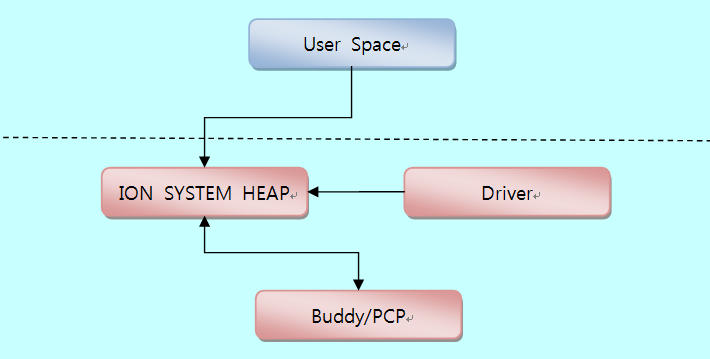
Android ION数据结构
ion_device
struct ion_device {
struct miscdevice dev;
struct rb_root buffers;
struct mutex buffer_lock;
struct rw_semaphore lock;
struct plist_head heaps;
...
struct rb_root clients;
...
};dev:具体平台上的ION设备
buffers:通过红黑树管理所有通过ion分配的ion_buffer
heaps:ion设备所有的heaps链表,通过plist(priority-sorted list)管理
clients:红黑树管理使用ion的所有ion_client
ion_client
struct ion_client {
struct rb_node node;
struct ion_device *dev;
struct rb_root handles;
struct idr idr;
struct mutex lock;
char *name;
char *display_name;
int display_serial;
struct task_struct *task;
pid_t pid;
struct dentry *debug_root;
};ion_client每个进程最多有一个
node:所有client所在的红黑树节点
dev:指向ion device
handles:该client所管理的所有ion_handle红黑树
task:client所属进程的task_struct
ion_handle
struct ion_handle {
struct kref ref;
struct ion_client *client;
struct ion_buffer *buffer;
struct rb_node node;
unsigned int kmap_cnt;
int id;
};ion_handle用于连接client与buffer,修改该结构需要lock所在的client
ref:引用计数
client:所属的ion_client
buffer:该handle使用的ion_buffer
node:client handles红黑树节点
id:每个client内唯一的id,由client->idr分配
ion_buffer
struct ion_buffer {
struct kref ref;
union {
struct rb_node node;
struct list_head list;
};
struct ion_device *dev;
struct ion_heap *heap;
unsigned long flags;
unsigned long private_flags;
size_t size;
union {
void *priv_virt;
ion_phys_addr_t priv_phys;
};
struct mutex lock;
int kmap_cnt;
void *vaddr;
struct sg_table *sg_table;
struct page **pages;
struct list_head vmas;
/* used to track orphaned buffers */
int handle_count;
char task_comm[TASK_COMM_LEN];
pid_t pid;
};ref:引用计数
node:ion_device buffers红黑树节点
heap:buffer来自的heap
kmap_cnt:ion_buffer映射到内核的次数
vaddr:如果kmap_cnt不为0,vaddr位内核映射
dmap_cnt:ion_buffer映射到dma的次数
sg_table:如果dmap_cnt不为0,为sg table
vmas:映射到ion_buffer的vma列表
handle:应用该ion_buffer的handle数
task_comm: 通过handle引用该ion_buffer的最后一个client所属进程
ion_heap
struct ion_heap {
struct plist_node node;
struct ion_device *dev;
enum ion_heap_type type;
struct ion_heap_ops *ops;
unsigned long flags;
unsigned int id;
const char *name;
struct shrinker shrinker;
void *priv;
struct list_head free_list;
size_t free_list_size;
spinlock_t free_lock;
wait_queue_head_t waitqueue;
struct task_struct *task;
int (*debug_show)(struct ion_heap *heap, struct seq_file *, void *);
atomic_t total_allocated;
atomic_t total_handles;
};node:ion device通过plist管理所有的ion_heap
type:ion heap类型
ops:ion heap的操作
id:ion heap id同时也表示优先级,id越小优先级越高,参考plist
free_list:deferred free list
free_list_size:size of deferred free list
waitqueue:queue to wait on from deferred free thread
task:task struct of deferred free thread
ion_system_heap
struct ion_system_heap {
struct ion_heap heap;
struct ion_page_pool **uncached_pools;
struct ion_page_pool **cached_pools;
};heap:关联的ion_heap
uncached_pools:空闲页所在的pool,如果ion heap的flag为uncached从此分配和释放
cached_pools: 空闲页所在的pool,如果ion heap的flag为cached从此分配和释放
ion_page_pool
struct ion_page_pool {
int high_count;
int low_count;
struct list_head high_items;
struct list_head low_items;
struct mutex mutex;
gfp_t gfp_mask;
unsigned int order;
struct plist_node list;
};high_count:pool中属于高端内存的内存块数目
low_count: pool中属于低端内存的内存块数目
hight_items:pool中属于高端内存的内存块链表
low_items: pool中属于低端内存的内存块链表
order:pool中内存块的阶,也就是pool中内存块的大小
4000
为(1<
小结
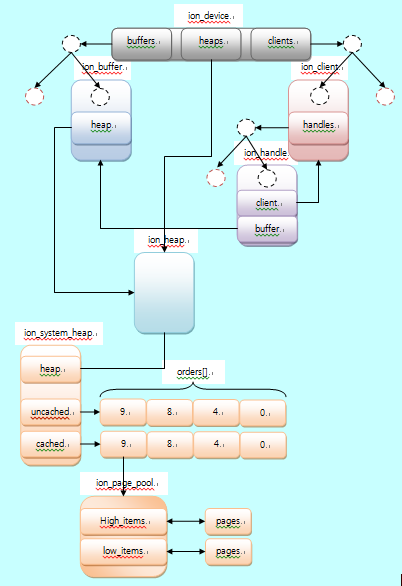
Android ION设备初始化
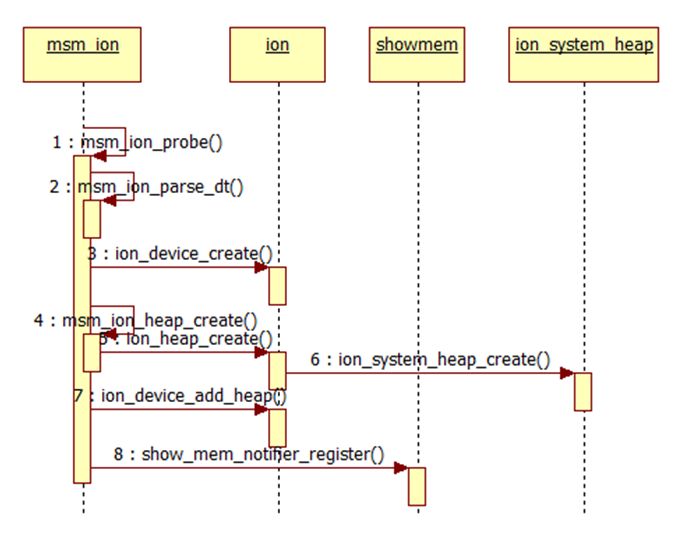
1. 解析ion dtsi配置获取系统当前配置的堆
2. 创建ion设备,同时在debugfs中创建ion目录以及ion目录下的heaps以及clients目录,最后 初始化ion device所管理的buffers/clients红黑树以及heaps优先级链表
3. 创建系统当前配置的堆,以system heap为例,创建ion_system_heap以及所管理的page pool
4. 根据堆的标志以及有无shrink函数,分别初始化ion heap的延迟释放ion_buffer链表以及注册shrink函数,根据ion heap的ID也就是优先级将其添加到设备的优先级链表中,在debugfs的ion/heaps下创建以堆名命名的目录
5. 注册show_mem_notifier,用于调试,当cat /sys/kernel/debug/show_mem_notifier时,调试信息将打印在kernel log中
ION system heap分配内存
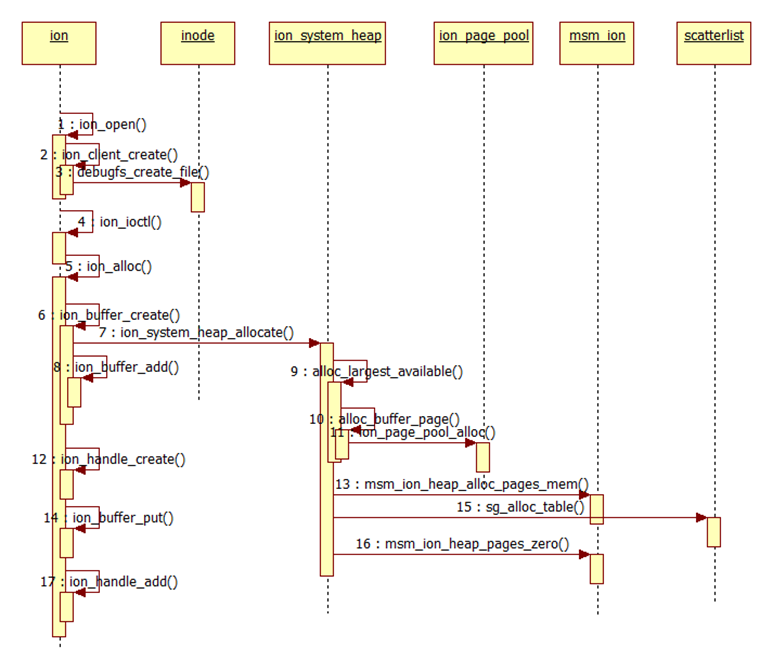
1. 在使用Ion heap之前,首先要open设备文件,在ion_open中为该进程创建ion_client,初始化ion_client后将其插入到ion dev的clients红黑树中,并未改client创建debugfs
2. 对于ion heap分配,我们从ion_alloc开始分析,在iondev的ion heap优先级链表中搜索我们请求的目标ion heap,如果找到调用ion_buffer_create
3. 在ion_buffer_create中首先创建ion_buffer,然后调用请求堆的allocate函数,这里我们只关心ion_system_heap_allocate
4. 重点分析ion_system_heap_allocate
static int ion_system_heap_allocate(struct ion_heap *heap, struct ion_buffer *buffer, unsigned long size, unsigned long align, unsigned long flags)
{
...
struct list_head pages;
struct list_head pages_from_pool;
struct page_info *info, *tmp_info;
int i = 0;
unsigned int nents_sync = 0;
unsigned long size_remaining = PAGE_ALIGN(size);
unsigned int max_order = orders[0];
struct pages_mem data;
...Pages为从PCP/buddy中分配的page链表
pages_from_pool为从Ion system heap page pool分配的page链表
data用来记录从PCP/buddy中分配的内存的大小
size_remaining用来表示本次需要分配的内存大小
...
while (size_remaining > 0) {
info = alloc_largest_available(sys_heap, buffer, size_remaining, max_order);
if (!info)
goto err;
sz = (1 << info->order) * PAGE_SIZE;
if (info->from_pool) {
list_add_tail(&info->list, &pages_from_pool);
} else {
list_add_tail(&info->list, &pages);
data.size += sz;
++nents_sync;
}
size_remaining -= sz;
max_order = info->order;
i++;
}
...alloc_largest_available每次分配小于size_remaining的最大的2的order次幂的内存,sz表示本次分配的内存大小,如果本次是从pool中分配的添加到pages_from_pool链表中,否则添加到pages链表,i表示分配size_remaining大小的内存用了多少次,nents_sync表示从PCP/buddy中分配内存块的个数(次数),这两个值是为了后面创建scatterlist服务,scatterlist可以认为是一个内存块的链表,后面的do while循环主要是为了将我们分配得到的pages_from_pool和pages两个链表进行合并
...
do {
info = list_first_entry_or_null(&pages, struct page_info, list);
tmp_info = list_first_entry_or_null(&pages_from_pool,
struct page_info, list);
if (info && tmp_info) {
if (info->order >= tmp_info->order) {
i = process_info(info, sg, sg_sync, &data, i);
sg_sync = sg_next(sg_sync);
} else {
i = process_info(tmp_info, sg, 0, 0, i);
}
} else if (info) {
i = process_info(info, sg, sg_sync, &data, i);
sg_sync = sg_next(sg_sync);
} else if (tmp_info) {
i = process_info(tmp_info, sg, 0, 0, i);
} else {
BUG();
}
sg = sg_next(sg);
} while (sg);
...将pages以及pages_from_pool链表中物理地址连续的内存块按照order大小,分别添加到sg以及sg_sync两个scatterlist中,其中pages中的内存块同时添加到两个scatterlist中,pages_from_pool中的只添加到sg scatterlist中。同时将data->pages初始化为sg_sync scatterlist中所有page页
分配到的内存的组织结构图
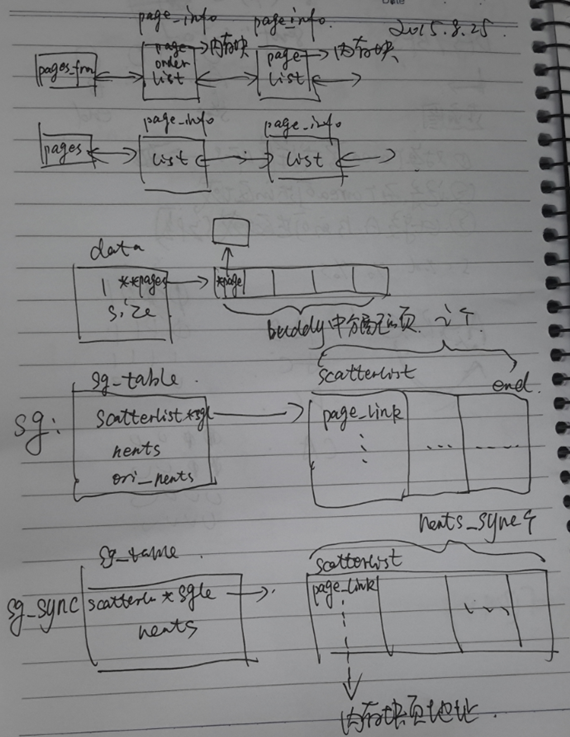
...
ret = msm_ion_heap_pages_zero(data.pages, data.size >> PAGE_SHIFT);
if (ret) {
pr_err("Unable to zero pages\n");
goto err_free_sg2;
}
if (nents_sync)
dma_sync_sg_for_device(NULL, table_sync.sgl, table_sync.nents,
DMA_BIDIRECTIONAL);
buffer->priv_virt = table;
if (nents_sync)
sg_free_table(&table_sync);
msm_ion_heap_free_pages_mem(&data);
return 0;
...利用data结构体,将从buddy分配到的所有内存块清零
对于dma_sync_sg_for_device,暂未搞懂
最后释放table_sync scatterlist以及data
在真正分配完内存之后,还需要创建ion_handle,初始化后添加到ion client所管理的handles红黑树中
ION system heap内存释放
当没有ion client引用ion buffer的时候,ion buffer就会被释放,通过上文我们知道ion buffer的可用内存实际上是由物理地址连续的多个内存块组成的scatterlist。释放的时候,就是遍历该scatterlist,释放该内存块,如果没有设置ION_PRIV_FLAG_SHRINKER_FREE标志,将内存块释放到ion system heap page pool;否则释放到PCP/buddy相关文章推荐
- Android LayoutInflater 详解
- Android复习之四大组件
- Android 画布学习Canvas (1)坐标
- 一张图将Activity与Fragment生命周期展现的淋漓尽致
- 使用Android Studio分析内存问题
- android developer tiny share-20160721
- android developer tiny share-20160721
- ANDROID开机动画bootanimation.zip的详细制作方法
- Activity的四种启动模式
- JNI学习积累之二 ---- 数据类型映射、域描述符说明
- android开发MadiaPlayer 发生IllegalStateException
- Android桌面悬浮窗进阶,QQ手机管家小火箭效果实现
- 相同androidprocess,相同androidsharedUserId探索
- android xlistView 魅族手机Hold问题
- JNI学习积累之一 ---- 常用函数大全
- 使用PagerSlidingTabStrip实现顶部导航栏
- Android中View转换为Bitmap及getDrawingCache=null的解决方法
- 关于JAVA中的listener回调机制,以及其在Android中的使用
- TextView设置超链接、背景颜色、字体颜色等等,Spannable的使用。
- Android应用开发SharedPreferences存储数据的使用方法
